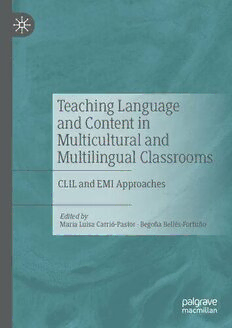
Teaching Language and Content in Multicultural and Multilingual Classrooms: CLIL and EMI Approaches PDF
Preview Teaching Language and Content in Multicultural and Multilingual Classrooms: CLIL and EMI Approaches
Teaching Language and Content in Multicultural and Multilingual Classrooms CLIL and EMI Approaches Edited by María Luisa Carrió-Pastor · Begoña Bellés-Fortuño Teaching Language and Content in Multicultural and Multilingual Classrooms · María Luisa Carrió-Pastor Begoña Bellés-Fortuño Editors Teaching Language and Content in Multicultural and Multilingual Classrooms CLIL and EMI Approaches Editors María Luisa Carrió-Pastor Begoña Bellés-Fortuño Departamento de Lingüística Aplicada English Studies Department Universitat Politècnica deValència Jaume I University Valencia, Spain Castellón, Spain ISBN 978-3-030-56614-2 ISBN 978-3-030-56615-9 (eBook) https://doi.org/10.1007/978-3-030-56615-9 ©The Editor(s) (if applicable) andThe Author(s), under exclusive license to Springer Nature Switzerland AG 2021 This work is subject to copyright. All rights are solely and exclusively licensed by the Publisher, whetherthewholeorpartofthematerialisconcerned,specificallytherightsoftranslation,reprinting, reuse of illustrations, recitation, broadcasting, reproduction on microfilms or in any other physical way,andtransmissionorinformationstorageandretrieval,electronicadaptation,computersoftware, or by similar or dissimilar methodology now known or hereafter developed. The use of general descriptive names, registered names, trademarks, service marks, etc. in this publicationdoesnot imply,evenintheabsenceof aspecific statement,thatsuch namesareexempt from the relevant protective laws and regulations and therefore free for general use. Thepublisher,theauthorsandtheeditorsaresafetoassumethattheadviceandinformationinthis book are believed to be true and accurate at the date of publication. Neither the publisher nor the authors or the editors give a warranty, expressed or implied, with respect to the material contained herein or for any errors or omissions that may have been made.The publisher remains neutral with regard to jurisdictional claims in published maps and institutional affiliations. ThisPalgraveMacmillanimprintispublishedbytheregisteredcompanySpringerNatureSwitzerland AG The registered company address is: Gewerbestrasse 11, 6330 Cham, Switzerland Contents Introduction 1 Begoña Bellés-Fortuño Part I CLIL and EMI CLIL vs EMI: Different Approaches or the Same Dog with a Different Collar? 13 María Luisa Carrió-Pastor “How Do I Find the Limit?”: Risk Management in EMI and CLIL at University 31 MonikaWoz´niak and Fiona Crean Part II English as a Medium of Instruction EMI Lecturers’ and Students’ Perceptions: Can EMI Contribute to Enhancing Intercultural Competence? 65 Marta Aguilar-Pérez v vi Contents Focus on Language in CBI: How Teacher Trainees Work with Language Objectives and Language-Focused Activities in Content-Based Lessons 97 Anna Krulatz Understanding Lecturers’ Practices and Processes: A Qualitative Investigation of English-Medium Education in a Spanish Multilingual University 123 Niall Curry and Pascual Pérez-Paredes The Challenges of EMI Courses in Armenian Higher Education Institutions (HEIs) 157 ZhenyaTer-Vardanyan Improving Second Language Writing Across the Disciplines: Resources for ContentTeachers 191 Renia López-Ozieblo Part III Content and Language Integrated Learning CLILandLiteraryEducation:TeachingForeignLanguages and Literature from an Intercultural Perspective—The Results of a Case Study 225 Josep Ballester-Roca and Camilla Spaliviero Meta-CLIL:When Methodology and Aim Meet in Initial TeacherTraining 253 Anna Marzà CLIL Assessment: Accommodating the Curricular Design in HE 293 Begoña Bellés-Fortuño Contents vii Essential Framework for Planning CLIL Lessons andTeachers’ AttitudesToward the Methodology 315 Francisco J. Álvarez-Gil Thinking Skills in Exam Models for CLIL Primary Subjects: Some Reflections forTeachers 339 María Ángeles Martín-del Pozo and Débora Rascón-Estébanez Concluding Remarks onTeaching Language and Content in Multilingual Classrooms: CLIL and EMI Approaches 369 María Luisa Carrió-Pastor Index 375 Notes on Contributors Marta Aguilar-Pérez is a lecturer at the Universitat Politècnica de Catalunya. Her recent research has focused on ESP/EAP and on foreign language education in multilingual classrooms within the international- ization trends in higher education. Francisco J. Álvarez-Gil isalecturerofEnglishlanguageandlinguistics in the Departmento de Filología Moderna,Traducción e Interpretación. Josep Ballester-Roca Professor in the Department of Language and Literature Pedagogy at the Universitat de València (Spain). His research focuses on aspects of reading, literary and intercultural education in multilingual contexts. Begoña Bellés-Fortuño, Ph.D. is a senior lecturer in the Department of English Studies at Universitat Jaume I, Spain, where she lectures English Studies degree students as well as in the degree of Medicine. María Luisa Carrió-Pastor is a professor of English language and the head of the Applied Linguistics Department at Universitat Politècnica ix x Notes on Contributors de València. She is the Coordinator of the Ph.D. program “Languages, Literatures, Cultures and their Applications”. Fiona Crean is a lecturer in Infant and Primary Education and a CLIL Teacher Trainer. She graduated from the University of Zaragoza in Spanish Philology and has a Postgraduate Diploma in Plurilingual Education from the University of Aberdeen. Niall Curry isalectureratUniversityofCoventry,heobtainedaPh.D. in Linguistics in January 2020. Débora Rascón-Estébanez is a primary school teacher, part time lecturer. She is a researcher on CLIL, children’s literature and active methodologies. Anna Krulatz is Professor in the Department of Teacher Edu-cation at the Norwegian University of Science and Technology in Trondheim, Norway. Renia López-Ozieblo is a L2 teacher and researcher and has been involved in a number of L2 related funded projects, including “Supporting Professional Development, Pedagogy & Language for Curriculum Learning”, the project under which this study was conducted. María Ángeles Martín-del Pozo is M.Sc. Computer Applications in Education, M.Phil. English Linguistics and a researcher on CLIL, EMI, teacher training and language didactics. Anna Marzà holds a Ph.D. in Audiovisual translation. In the Depart- ment of Pedagogy, Social Sciences and Language and Literature Didac- tics of the Universitat Jaume I, she lectures in Teaching of English as a Foreign Language and Integrated LanguageTeaching. Pascual Pérez-Paredes is a professor at University of Murcia, he also collaborates with the University of Cambridge. Camilla Spaliviero isaPh.D.studentattheDepartmentofLinguistics and Comparative Cultural Studies of Ca’ Foscari University of Venice (Italy). Notes on Contributors xi ZhenyaTer-Vardanyan has focused on developing business commu- nication skills for Armenian students. Currently, her research mainly focuses on language teaching methodology, investigation of CLIL and EMI practices in Armenian, Spanish and Swedish contexts. MonikaWoz´niak graduated from the University of Gdan´sk with a Master’s degree in English Philology and earned her European Ph.D. at the University of Jaén.
